Newly Declassified Documents Reveal that President George W. Bush Authorized Shootdown of Hijacked Airplanes on 9/11 – But Only After Three Planes Had Already Crashed (1)
Bush’s delayed actions point to failure of government response.
9/11 families are at the forefront in pressing for a new congressional investigation which could help unravel many mysteries about deadly terrorist attacks.
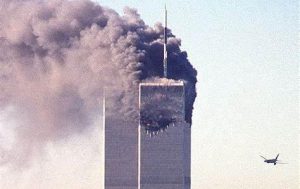
Recently released documents from the National Archives detail how President George W. Bush authorized the shootdown of hijacked airplanes at 10:00 a.m. EDT on 9/11 after he had learned that two had already crashed into the World Trade Center towers.
But these orders were too late to save the people who died in the Twin Towers or 183 people who died when the western side of the Pentagon was struck by American Airlines Flight 77 at 9:37 a.m. (the fourth hijacked plane, Flight 93, crashed southeast of Pittsburgh in Somerset County, Pennsylvania, at 10:03 a.m. after passengers reportedly took over the plane).
The sixty-four thousand dollar question is why Bush did not order the shootdown of the planes earlier – when it could have saved people’s lives.
Bush had been alerted just minutes after a hijacked plane crashed into the World Trade Center at 8:46 a.m., while he was on a visit to schoolchildren in Sarasota, Florida.
After an aide whispered news of the second attack on the Twin Towers, President Bush continued reading a children’s book, The Pet Goat, and then at 9:30 a.m. addressed Americans at a press conference in which he said that “terrorism against our nation will not stand,” before being whisked away and stopped at about seven locations that were reported, including Barksdale Air Force Base.
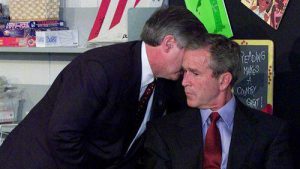
Bush’s orders authorizing the shooting down of hijacked aircraft were revealed in a meeting that he held on April 29, 2004, with members of the 9/11 Commission, which was established to investigate the 9/11 attacks.1
In the meeting, President Bush claimed that he wanted to convey an aura of calm in the face of the attacks and so continued with the reading to the schoolchildren in Florida.
Bush said that it was when he got aboard Air Force One and began speaking to Dick Cheney that he gave Cheney authorization to shoot down any hijacked aircraft.
Bush said that he told Cheney that, as a veteran of the Texas National Guard (during the Vietnam War), he had been trained to shoot down planes and understood how this worked – one plane would identify the target and another would lock onto it.
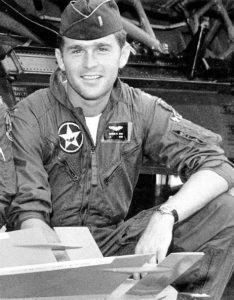
But why hadn’t Bush ordered the hijacked planes to be shot down an hour earlier, when he was first informed about the World Trade Center attacks and lives could have been spared?

Failings of 9/11 Commission
Coinciding with the 20th anniversary of the 9/11 attacks, Ray McGinnis published an important book, Unanswered Questions: What the September Eleventh Families Asked and the 9/11 Commission Ignored (Vancouver, Canada: NorthernStar Publications, 2021), which spotlights the efforts of 9/11 families to uncover the truth about the 9/11 attacks and to demand a new government inquiry.
A Canadian who wrote a previous book on the psalms, McGinnis emphasizes the failure of the 9/11 commission, which was staffed by Bush administration insiders and yes-men, and spent only $14 million investigating the 9/11 attacks when $80 million had been spent in the 1990s investigating Bill and Hillary Clinton’s involvement in assorted scandals.
A group of 9/11 families gave the commission a D-grade, stating that it “did not carry out the necessary hard-hitting questioning, cross-examination and crucial follow-up questioning all of which are critical in unearthing the truth.”
The credibility of the Commission was undercut by the fact that it published the names and photos of hijackers, eight who according to media reports were found to be alive after September 11 – and so not all of these could actually have been the hijackers.2
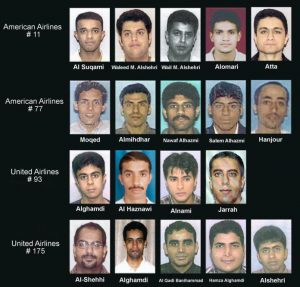
Chairman Thomas Kean, the former governor of New Jersey, and Vice Chairman Lee Hamilton, a former congressman from Indiana (1965-1999), admitted that the commission had been “set up to fail.”
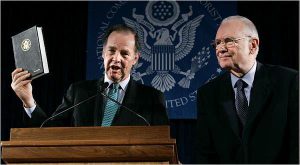
Fitting the precedent of the Warren Commission investigating the JFK assassination, and Roberts Commission investigating Pearl Harbor, Max Cleland said that the 9/11 Commission [which Cleland served on] had been “compromised.”
Lee Hamilton tellingly was a firm believer in “executive privilege” who was not considered much of an investigator in Congress. He admitted that he did not “go for the jugular” and had been “gullible” in accepting official government claims during the Iran-Contra investigation.
When others wanted to issue subpoenas to North American Aerospace Defense Command (NORAD) officers, Hamilton characteristically voted no, stating: “I’ve known Don Rumsfeld [Defense Secretary] for twenty, thirty years. When he said ‘I’m going to get that information for you,’ I took him at his word.”3
Philip Zelikow, the executive director of the 9/11 Commission had been on President Bush’s foreign intelligence advisory board and on the Council of Foreign Relations, and was a key contributor to a policy paper advocating preemptive war, which laid the intellectual groundwork for the invasion of Iraq in 2003.4
Zelikow’s bias was apparent when the 9/11 Commission solicited the testimony of Dr. Laurie Mylroie, author of the book, Study of Revenge: Saddam Hussein’s Unfinished War Against America, who claimed that Iraq had attacked the U.S. on 9/11.
Lorie Van Auken, whose husband was killed on 9/11, told New York Times reporter Philip Shenon that “it took a lot of nerve putting someone like that on the panel. Laurie Mylroie? This is supposed to be an investigation for September 11. This is not supposed to be a sales pitch for the Iraq War!” Van Auken continued: “He knew exactly what he was doing. He was selling the war.”

Unaddressed Questions
McGinnis summarizes some of the main question marks about 9/11 that families of the survivors had which the 9/11 Commission never addressed. These questions include:
How did the FBI amass complete biographies of the alleged terrorists and their accomplices in such a short time after the attacks? Did the intelligence agencies have open files on these men? Were they already under investigation and, if so, could the attacks have been prevented?
How come Osama bin Laden appeared to be healthy and with a brown beard in a November 9, 2001 “confession” video, when he appeared to be frail, gaunt and pale with a white beard in other videos purportedly taken on November 3 and November 16 same year?
How come the doors to the roofs of the World Trade Center North and South Towers were locked, preventing people in the buildings from being rescued by helicopter – as they had been after the 1993 World Trade Center bombing?
Why did George Tabeek of the Port Authority of New York and New Jersey give orders for an announcement after the first tower was struck that people should return to their offices in World Trade Center building 2, which cost many people their lives?5
Why did the Federal Aviation Administration (FAA), American Airlines and NORAD each report different times for orders to send out fighter jets to intercept the hijacked planes and why were the planes never intercepted?
Why was Defense Secretary Donald Rumsfeld not informed about the 9/11 attacks when they occurred? And why was the Pentagon undefended when it oversaw a trillion dollar budget for national defense?
How was it possible that the passports of alleged hijackers Mohamed Atta and Satam al-Suqami were found at street level in the rubble of the World Trade Center, unsinged?
Why did FBI headquarters block agent Coleen Rowley in Minneapolis, agent Robert Wright in Chicago, and the FBI offices in New York City from properly reporting evidence of terrorist plotting?
Why did the FBI, who had Mohamed Atta under surveillance, do nothing to prevent him from re-entering the U.S. three times in 2001, despite his expired visa?
Why were members of the bin Laden family flown from the U.S. to Saudi Arabia right after the 9/11 attacks when all commercial and private flights were officially grounded?
Why did the CIA withhold information from the FBI about two of the alleged hijackers, Nawaf al-Hazmi and Khalid al-Mihdhar?
Where Were the Eyes and Ears of North American Skies?
One of the biggest unanswered questions that the 9/11 Commission failed to address was why NORAD jets were unable to intercept the hijacked planes if they were airborne within eight minutes of notification?
Founded in 1957 as a joint command military organization between the U.S. and Canada, NORAD was the “multimillion dollar, 24-hour eyes and ears of North American skies.”

Holding an impeccable record in aviation safety, it had successfully intercepted 129 off-course flights in 2000 over U.S. air space, and carried out anti-hijack training exercises every six days.
After a 1956 mid-air crash over the Grand Canyon, the FAA had made it mandatory for all planes to have approved flight paths tracked by radar and to have their cruising altitude approved before take-off.
An Air Traffic Control Center binder from August 1998 counseled controllers that, when a plane strayed from its approved flight path or altitude assignment, it will “likely find two [jet fighters] on their tail within 10 minutes or so.”6
On 9/11 these jet fighters could have been able to perform aerial maneuvers around the hijacked flights to force them off course. However, inexplicably, neither the FAA and NORAD followed its normal protocol on 9/11, and its top commanders went AWOL (military term meaning “absent without official leave but without intent to desert”) during the attacks.
NORAD Commander Ralph Eberhart was himself unreachable for 45 minutes between 9:30 a.m. and 10:15 a.m. while driving his car. Eberhart claimed in an interview on March 1, 2004, that he chose to be absent from the command post for 45 minutes while the attacks were unfolding because they had “quieted down,” which is ridiculous.7
The 9/11 Commission Report conceded that the response by NORAD was “one failure after another,” though it did not investigate these failures in any depth, nor uncovered their root cause.
Lorie Van Auken, a member of the 9/11 Family Steering Committee, said that she was stunned that the 9/11 Commission Report omitted the fact that there were two fighter jets from the Atlantic City International Airport in Pomona, New Jersey, carrying out mock bombing sorties only eight minutes away from ground zero that were never called.
Paul Thompson, author of The Terror Timeline, commented that the 9/11 Commission considered a criminal investigation of NORAD and Pentagon officials who gave the inquiry seven different, and contradictory, stories regarding the military response to the hijackings.
Strangely, while two of the flight attendants from the hijacked planes contacted the airline to alert them that a hijacking was in progress and it was protocol to notify NORAD of any hijacking in progress, under NORAD’s timeline no one was in touch with them until much later.
The FAA also only received word of the hijackings at 9:34 a.m., over an hour after air traffic controllers at Boston Center began notifying the FAA that a hijacking had taken place.
References:
1. Bush attended the meeting along with Vice President Dick Cheney, 9/11 Commission Executive Director Philip Zelikow, Attorney General Alberto Gonzalez, and two other Bush administration officials (Tom Monheim and Bryan Cunningham).
2. Ray McGinnis, Unanswered Questions: What the September Eleventh Families Asked and the 9/11 Commission Ignored (Vancouver, B.C.: Northern Star Publications, 2021), 284, 285. Information that the 9/11 commission obtained about the hijackers came from statements made by Guantanamo Bay detainees under torture, and should thus be suspect.
3. McGinnis, Unanswered Questions, 44.
4. Zelikow had written a book with Secretary of State Condoleezza Rice on German reunification and another on the Cuban Missile Crisis, which was called out in The Atlantic magazine for its shoddy scholarship.
5. McGinnis, Unanswered Questions, 157. The announcement was made by Philip T. Hayes, WTC Fire Safety Director for the South Tower (and retired New York City firefighter) based on instructions from Tabeek. Hayes strangely appealed to people’s sense of patriotism, saying “this tower has been secured. You are in America. Return to your offices.”
6. In testimony before the Senate Armed Services Committee in March 2002, NORAD Commander Ralph Eberhart explained that, once FAA suspects something is wrong with a flight over domestic airspace, “it takes about one minute” for them to notify NORAD, which could in turn scramble jets within 2.5 minutes up to an altitude of 29,000 feet “to anywhere in the U.S.”
7. In 2002, Eberhart was promoted to head the U.S. Northern Command.
Read the second part of the article
yogaesoteric
January 31, 2023
